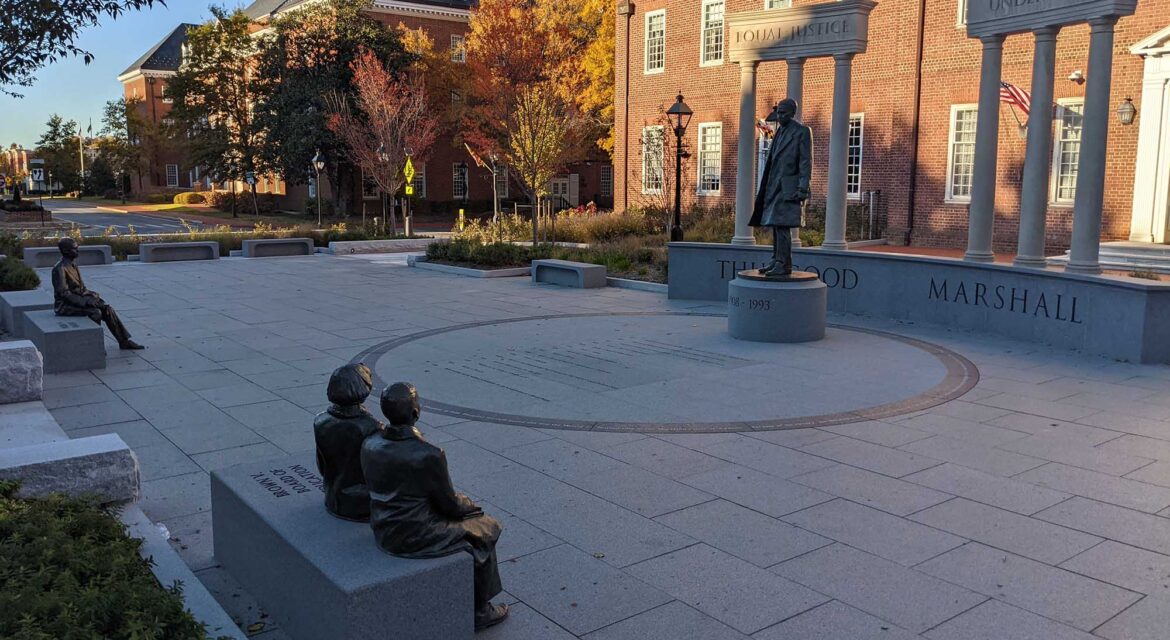 Honoring the first African-American Supreme Court Justice, the Thurgood Marshall Memorial defines State House Square in Annapolis, Maryland. Connecting audiences to the history of the country as well as the legacy of an individual that helped define the Civil Rights movement in the United States, the memorial has provided the space with an identity that cultivates engagement on multiple levels.
Honoring the first African-American Supreme Court Justice, the Thurgood Marshall Memorial defines State House Square in Annapolis, Maryland. Connecting audiences to the history of the country as well as the legacy of an individual that helped define the Civil Rights movement in the United States, the memorial has provided the space with an identity that cultivates engagement on multiple levels.

A Leader in the Struggle for Equal Rights
 Thurgood Marshall was an American lawyer and civil rights activist who was born in Baltimore, Maryland. One of the 20th century’s foremost leaders in the struggle for equal rights under the law, he argued against school segregation on numerous occasions, including the famous Brown v. The Board of Education of Topeka et. al. In 1967 he became the first African American to be appointed to the U.S. Supreme Court. Following his death in 1993, the state of Maryland decided to honor him with the creation of a memorial at the State House in Annapolis.
Thurgood Marshall was an American lawyer and civil rights activist who was born in Baltimore, Maryland. One of the 20th century’s foremost leaders in the struggle for equal rights under the law, he argued against school segregation on numerous occasions, including the famous Brown v. The Board of Education of Topeka et. al. In 1967 he became the first African American to be appointed to the U.S. Supreme Court. Following his death in 1993, the state of Maryland decided to honor him with the creation of a memorial at the State House in Annapolis.
Dedicated in 1996, the memorial sits on the site of the old Court of Appeals building where Marshall argued some of his early civil rights cases. The Thurgood Marshall Memorial is defined by an 8′ statue of Marshall that depicts him as a young lawyer. Other features include statues of two children and a separate one of Donald Gaines Murray, both of which represent his multiple fights for civil rights. Within the circle of the plaza is a chronology of the important events in Marshall’s life and career.
Created by Maryland artist Toby Mendez, the memorial is just one of the many memorials that surround the Maryland State House but has come to define Lawyer’s Mall/State House Square. This has helped attract the attention of residents and visitors, highlighting what it can mean for a monument to provide a space with such a powerful identity.

Transforming a Space
 Thurgood Marshall had an incredible impact on the history and culture of the state and nation but the Thurgood Marshall Memorial highlights what it can look like to celebrate the legacy of an individual no matter their accolades or contributions. Doing so at State House Square has positively transformed this space in a way that creates engagement for audiences in the present and future.
Thurgood Marshall had an incredible impact on the history and culture of the state and nation but the Thurgood Marshall Memorial highlights what it can look like to celebrate the legacy of an individual no matter their accolades or contributions. Doing so at State House Square has positively transformed this space in a way that creates engagement for audiences in the present and future.

